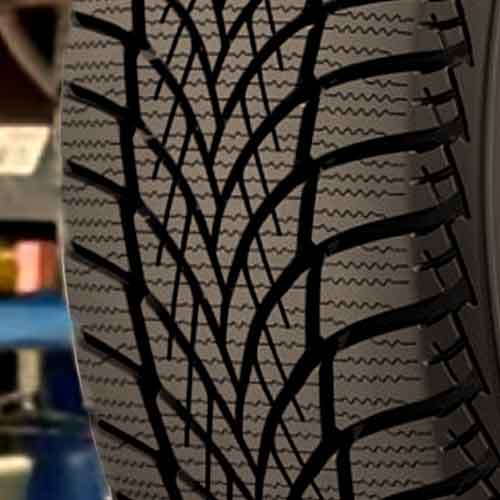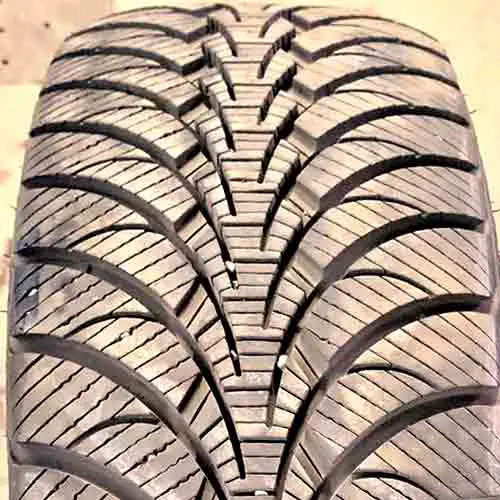Winter tire giants Goodyear WinterCommand Ultra and Goodyear Ultra Grip Ice WRT, both famed for their unique strengths, are set to face off. Let’s see, which tire is a better fit for your needs.

Table of Contents
Key Takeaway
The Goodyear WinterCommand Ultra (review) takes the lead when it comes to:
- Wet Traction: Enhanced groove design and sipes, superior hydroplaning resistance.
- Ice Performance: Unique tread design with angular cuts; lighter weight offers better handling.
- Directional Grip: Streamlined central rib and angular biters for superior straight-line stability.
- Handling: Better road connectivity during cornering and improved handling due to weight.
- Fuel Economy: Lower rolling resistance leading to better mpg.
- Vibration Absorption: Advanced compound for superior cushioning against road inconsistencies.
On the other side, Goodyear Ultra Grip Ice WRT excels in:
- Snow Performance: Spacious tread pattern and in-groove notches for enhanced snow traction.
- Tread Life: Deeper tread depth and stiffer rubber, giving more mileage before wear limit.
- Noise Generation: Advanced pitch sequencing technology reduces resonance noise.
Wet Traction
In the tire performance world, a key feature is wet traction, primarily determined by tread patterns and rubber composition. Both contenders here, specifically designed for winter conditions, display commendable performance, where they offer numerous tread voids that efficiently drain water, reducing the risk of hydroplaning and improving grip on wet roads.
However, the Goodyear WinterCommand Ultra slightly outperforms its competitor.

It uses a smart blend of interlocking and straight sipes with aggressive edges for better traction.
Additionally, its flexible tread enables the sipes to effectively absorb water particles under the tire, enhancing its grip.
Though the main reason, why this tire excels here, is it’s grooves.
You see grooves take out majority of water, and they are more efficient on this tire, relatively speaking.
Not only the tire offers greater tread depth on average, in comparison, the better interconnection of the grooves allow for more water going out at a given time, (and tire gets to be more resistant to hydro or aquaplaning).
And more water that goes out through the grooves, the less gets left behind.
And so sipes don’t have to work so much. Meaning, the overall wet performance gets enhanced.
(Just adding a note here, for folks who don’t know, hydroplaning happens when a tire floats, when water comes between the tire and the road).
Overall in essence, the WinterCommand Ultra offers superior resistance to hydroplaning and wet grip.
Snow Performance
In soft snow conditions, both tires perform excellently, being designed to handle challenging winter scenarios. Yet, the Ultra Grip Ice WRT takes the lead with its unique, spacious tread pattern and lugs that enable effective snow-to-snow contact.

Its tread voids act like snow traps, collecting snow particles to create a snow layer that increases traction since snow sticks better to snow than rubber.
Moreover, although both tires offers directional patterns, the Ultra Grip WRT also features curved in-groove notches, connecting the lateral grooves made by swooping arms.
These basically add to the shovelling effect of the tire. Meaning this tire offers better throwing of snow backwards, creating forward momentum.
And this enhanced acceleration force also helps the tire with overall handling. That’s because once the corner is over, tires need to re-accelerate.
On the other hand, the WinterCommand Ultra, while decent, uses a less aggressive tread pattern and fails to gather snow as efficiently.
So this ones a win for Ultra Grip Ice WRT.
Ice Performance
On icy surfaces, the WinterCommand Ultra outshines its counterpart, with its unique tread design featuring a combination of angular cuts and V-shaped notches of different sizes and orientations.
And these, coupled with an intensely siped pattern, this design ensures faster braking and improved handling on ice.
Though besides biters, the tire also takes the lead due to its lighter construction overall.
With lighter weight, there’s basically a smaller momentum force created on the tire, and that leads to faster overall handling and steering responsiveness.
(Momentum is inversely proportional to tire’s steering response).
So in terms of ice traction, the Goodyear WinterCommand Ultra offers better overall results.
Directional Grip
The performance of straight-line stability primarily relies on the central tread area, which carries most of the tire’s load during straight-line driving. And here, the WinterCommand Ultra excels, with a more streamlined central rib that increases ground contact.
Not only the tire offers greater rubber to road contact, but its angular biters provide grip in all directions as well, and not just in the longitudinal way.
Moreover, with the tire’s lighter weight, there’s also a smaller momentum force created, as the tire speeds up. This means, its easier to slow down the tire, compared to its counterpart.
That’s why you see this tire braking 5 feet shorter in comparison (it’s important, because directional grip is directly measured by braking).
In contrast, the Ultra Grip Ice WRT’s in-groove notches reduce the amount of rubber contacting the ground, negatively impacting straight-line stability.
So overall, Goodyear WinterCommand is leading here, literally, as it offers better acceleration too (another way to determine directional grip, besides braking).
Handling
Handling ability, or lateral traction, hinges on shoulder lug performance. When a tire turns corners, the weight shifts to the tread edges or shoulders, affecting handling. Here, the Ultra Grip Ice WRT lacks, due to its less compact shoulder design and heavier weight.
The tire’s design basically offers less road connectivity (from shoulders), during cornering, providing less balanced steering feedback and improved handling. That’s why it’s seen trailing by about a second on average in lap times (tests).
Though besides connectivity, its greater weight is causing the main problem, in my opinion. Being heavier, as it turns, it pushes down on its lugs more, causing them to bend.
And that then results in lagging steering.
So overall, this ones a win for WinterCommand.
Fuel Economy
The efficiency of fuel utilization in a vehicle is largely determined by the tire’s rolling resistance, which is fundamentally the interaction, or ‘stickiness,’ of the tread with the road surface.
In this context, the Goodyear Ultra Grip Ice WRT lacks with it’s greater tread depth and heavier weight, causing lugs to bend more, even though it comes with a relatively harder compound.
On the other hand, Wintercommand keeps its lugs more composed, so they exhibit reduced flexibility, minimizing deformation during cornering, braking, or acceleration.
This decreased flexibility results in diminished heat generation and total energy consumption, consequently augmenting fuel efficiency.
So WinterCommand offers better mpg in comparison.
Tread Life
In the domain of tread longevity, winter tires typically face challenges due to the softer rubber composition that is subject to faster wear. Consequently, it’s anticipated that both tires exhibit comparable, albeit not particularly exceptional, performance in this regard.
The Goodyear WinterCommand Ultra, featuring thermally adaptive rubber designed to withstand harsh winter temperatures, suffers from expedited wear.
Whereas the Goodyear Ultra Grip Ice WRT with deeper tread depth, and a stiffer rubber lasts longer.
So its rubber (being more durable), doesn’t wear down quicker, and extra tread depth provides additional mileage before reaching the legally permissible limit of 2/32″ tread depth.
Thus, despite the quicker wearing of rubber, the WRT maintains tread longevity comparable to its rival.
Vibration Absorption
Tires function as the secondary suspension system in a vehicle, absorbing road imperfections and providing a smooth ride. In this aspect, the Goodyear WinterCommand Ultra takes the lead, given its advanced compound offering superior thermal adaptability and excellent cushioning against road inconsistencies.
When the tire encounters uneven surfaces, it effectively dissipates these disturbances, facilitating a notably smoother ride.
On the flip side, the Goodyear Ultra Grip Ice WRT, does the opposite, where with its stiffer tread compound, doesn’t quite reach this level of comfort.
Though it does take the lead, when it comes to noise.
Noise Generation
The primary source of tire noise is the air entering the tire’s shoulder voids and generating unwanted sound waves through collisions with the tire walls.
This noise is further intensified by in-groove resonance, a phenomenon where sound waves echo within the tire.
That’s why while the Goodyear WinterCommand Ultra initially produces similar noise levels, its softer compound tends to amplify the resonance, leading to louder noise.
Conversely, the Goodyear Ultra Grip Ice WRT pulls ahead due to its advanced pitch sequencing technology. This innovative design approach alters the geometry of the tread blocks to generate varying sound frequencies, which effectively neutralize each other, reducing resonance noise.
To Sum It All Up
So overall, both tires have their pros and cons, and they offer unique attributes in different performance areas.
The Goodyear WinterCommand Ultra excels in wet and icy conditions, providing superior hydroplaning resistance, handling, and braking.
Moreover, it’s streamlined design also ensures optimal directional grip and vibration absorption.
Meanwhile, the Goodyear Ultra Grip Ice WRT stands out on snowy terrains with its unique tread pattern.
It also offers a longer tread life and a quieter ride due to advanced pitch sequencing technology.
However, the WinterCommand leads in fuel economy, thanks to its minimized rolling resistance.